|
Sunday:
April 6, 2003 | |
0410 GMT |
 |
Titan 4 to launch final Milstar spacecraft today
A 10,000-pound, $800 million satellite that will serve as an orbiting switchboard for secure communications between senior U.S. leaders and military forces around the world is slated for launch at 9:51 a.m. EDT today atop a Titan 4 rocket from Cape Canaveral, Florida.
 MISSION STATUS CENTER - updates MISSION STATUS CENTER - updates
 LAUNCH EVENTS TIMELINE LAUNCH EVENTS TIMELINE
 PREVIEW STORY PREVIEW STORY
 |  |
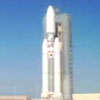
|
 |
Europe's Ariane 5 rocket given OK for return to flight
Officials in control of the final steps prior to Tuesday's flight of an Ariane 5 rocket have cleared the vehicle and its two payloads for liftoff in a launch readiness review. A meeting Saturday ended with a "go" to continue operations for the launch.
 MISSION STATUS CENTER - updates MISSION STATUS CENTER - updates
 PREVIEW STORY PREVIEW STORY
 LAUNCH EVENTS TIMELINE LAUNCH EVENTS TIMELINE
 ARCHIVED ARIANE COVERAGE ARCHIVED ARIANE COVERAGE
 |  |

|
 |
Galactic wind of low-energy cosmic rays claimed
A bit of Earth-bound chemistry has led scientists at the University of California, Berkeley, to conclude that there is an unsuspected wind of low-energy cosmic ray particles blowing through the galaxy.
 FULL STORY FULL STORY
 |  |
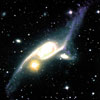
|
 |
|
Saturday:
April 5, 2003 | |
0218 GMT |
 |
Splashing down on oceans of Saturn's moon Titan
Titan, Saturn's largest moon, is a mysterious place. Its thick atmosphere is rich in organic compounds. Some of them would be signs of life if they were on our planet. How do they form on Titan? Will they help us to discover how life began on Earth?
 FULL STORY FULL STORY
 |  |
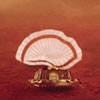
|
 |
20th century climate not so hot, study shows
A review of more than 200 climate studies led by researchers at the Harvard-Smithsonian Center for Astrophysics has determined that the 20th century is neither the warmest century nor the century with the most extreme weather of the past 1000 years.
 FULL STORY FULL STORY
 |  |

|
 |
|
Friday:
April 4, 2003 | |
0517 GMT |
 |
Ariane 5 program looks for successful return to flight
Arianespace is setting up for a crucial flight next week of the Ariane 5 rocket that promises to be widely watched throughout the aerospace industry after the last mission of the heavy-lift booster ended in failure and prompted a program-wide review.
 FULL STORY FULL STORY
 LAUNCH EVENTS TIMELINE LAUNCH EVENTS TIMELINE
 ARCHIVED ARIANE COVERAGE ARCHIVED ARIANE COVERAGE
 |  |
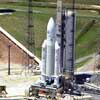
|
 |
Hubble's rainbow image of a dusty star
Resembling a rippling pool illuminated by underwater lights, the Egg Nebula offers astronomers a special look at the normally invisible dust shells swaddling an aging star. These dust layers, extending over one-tenth of a light-year from the star, have an onionskin structure that forms concentric rings around the star.
 FULL STORY FULL STORY
 |  |

|
 |
Giant cosmic lens reveals secrets of distant galaxy
Using a radio telescope and helped by a gigantic cosmic lens conveniently provided by nature, an international team of astronomers has discovered that a young galaxy had a central disk of gas in which hundreds of new stars were being born every year -- at a time when the Universe was only a fraction of its current age.
 FULL STORY FULL STORY
 |  |

|
 |
|
Thursday:
April 3, 2003 | |
0020 GMT |
 |
Final Milstar spacecraft to launch Sunday
A 10,000-pound, $800 million satellite that will serve as an orbiting switchboard for secure communications between senior U.S. leaders and military forces around the world is slated for launch Sunday atop a Titan 4 rocket.
 FULL STORY FULL STORY
 MISSION STATUS CENTER - updates MISSION STATUS CENTER - updates
 |  |

|
 |
Launch industry doldrums unlikely to end soon
The current depression in the commercial launch market that has hurt launch vehicle operators in the United States and Europe will continue for the foreseeable future, with government support becoming vital to sustain the industry, a panel of experts recently concluded.
 FULL STORY FULL STORY
 |  |

|
 |
NASA researchers put new spin on relativity theory
Albert Einstein might be astonished to learn that NASA physicists have applied his relativity theory to a concept he introduced but later disliked namely that two particles that interact could maintain a connection even if separated by a vast distance. Researchers often refer to this connection as "entanglement."
 FULL STORY FULL STORY
 |  |

|
 |
Europe studies missions to safeguard the Earth
Early on the morning of June 30, 1908, the vast forest of western Siberia was illuminated by a strange apparition: an alien object streaking across the cloudless sky. White hot from its headlong plunge into the Earth's atmosphere, the intruder exploded about 8 km above the ground, flattening trees over a vast area.
 FULL STORY FULL STORY
 |  |

|
 |
|
Wednesday:
April 2, 2003 | |
0701 GMT |
 |
Mystery object shed in orbit possibly a carrier panel
The radar signature of an object floating away from the shuttle Columbia on the second day of its mission matches up well with a wing leading edge carrier panel, members of the Columbia Accident Investigation Board revealed Tuesday. If Columbia began its ill-fated re-entry with a missing carrier panel, enough heat could have entered the left wing to trigger the catastrophic chain of events that led to the shuttle's destruction.
 FULL STORY FULL STORY
 |  |
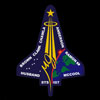
|
 |

Video coverage for subscribers only:
 VIDEO: TUESDAY'S ACCIDENT BOARD NEWS BRIEFING QT VIDEO: TUESDAY'S ACCIDENT BOARD NEWS BRIEFING QT
 SUBSCRIBE NOW SUBSCRIBE NOW

|
NASA formally announces Expedition 7 station crew
Veteran Russian cosmonaut Yuri Malenchenko and veteran NASA astronaut Ed Lu have been named as the primary crew for the planned April 26 launch of a Russian Soyuz TMA-2 spacecraft to the International Space Station.
 FULL STORY FULL STORY
 |  |

|
 |
One of closest and brightest gamma ray bursts detected
The Universe clearly works weekends; delivering one of the brightest and closest gamma ray bursts yet on Saturday. NASA's High-Energy Transient Explorer (HETE) detected the burst, signaling the birth of a black hole, in the constellation Leo.
 FULL STORY FULL STORY
 |  |

|
 |
Military spacecraft launched by Russian forces
Russia successfully launched a military cargo into orbit today from its northern cosmodrome. The Molniya M booster carried a Molniya-type military communications satellite into a highly-inclined, egg-shaped orbit.
 |  |
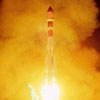
|
 |
|
Tuesday:
April 1, 2003 | |
0524 GMT |
 |
Delta doesn't disappoint in successful GPS launch
A new satellite to replenish the U.S. military's preeminent space-based navigation network roared off the planet Monday, destined to circle 11,000 miles above the globe to guide soldiers in the battlefield and civilians around the world.
 FULL STORY FULL STORY
 LAUNCH PHOTO GALLERY LAUNCH PHOTO GALLERY
 MISSION STATUS CENTER MISSION STATUS CENTER
 |  |

|
 |

Video coverage for subscribers only:
 VIDEO: THE DELTA 2 ROCKET LAUNCHES WITH GPS 2R-9 QT VIDEO: THE DELTA 2 ROCKET LAUNCHES WITH GPS 2R-9 QT
 VIDEO: ALTERNATE VIEW OF LIFTOFF FROM NORTH OF PAD QT VIDEO: ALTERNATE VIEW OF LIFTOFF FROM NORTH OF PAD QT
 VIDEO: INTERVIEW WITH LAUNCH SQUADRON COMMANDER QT VIDEO: INTERVIEW WITH LAUNCH SQUADRON COMMANDER QT
 VIDEO: INSIGHT ABOUT GPS FROM GULF WAR VETERAN QT VIDEO: INSIGHT ABOUT GPS FROM GULF WAR VETERAN QT
 VIDEO: POST-LAUNCH COMMENTS FROM BLS PRESIDENT QT VIDEO: POST-LAUNCH COMMENTS FROM BLS PRESIDENT QT
 SUBSCRIBE NOW SUBSCRIBE NOW

|
Gehman calls recorder data a 'treasure trove'
Ongoing analysis of a "treasure trove" of data from a recorder recovered in the wreckage of the shuttle Columbia shows a deadly plume of super-heated air first began eating its way into the ship's left wing just five minutes after the orbiter fell into the discernible atmosphere. The sudden temperature increase, in a cavity behind the U-shaped panels making up the leading edge of the left wing, came a full three minutes earlier than previous telemetry indicated the start of unusual heating.
 FULL STORY FULL STORY
 |  |

|
 |
More internal NASA emails released to public
NASA has posted nearly 30 megabytes of internal email traffic and attachments regarding the potential threat of foam debris striking the shuttle Columbia's left wing; concerns about corrosion that could interfere with proper operation of the ship's body flap during entry; and discussions regarding Columbia's heavier-than-usual landing weight.
 FULL STORY FULL STORY
 |  |

|
 |
|
Monday:
March 31, 2003 | |
0015 GMT |
 |
Temperature rose in wing earlier than known
A data recorder recovered in the wreckage of the shuttle Columbia shows hot gas entered the leading edge of the spacecraft's left wing within 16 seconds of the point when the orbiter entered the region of maximum aerodynamic heating during re-entry Feb. 1. Temperature sensors located behind two leading edge panels, both just outboard of the point where engineers believe a deadly breach occurred, showed a sudden rapid spike, or increase, before the sensors failed and dropped off line.
 FULL STORY - updated with more details FULL STORY - updated with more details
 |  |

|

